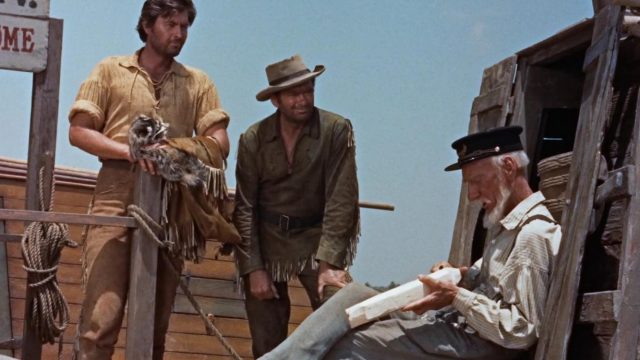I’m not sure if I knew that Mike Fink was a real person. (Actually, Wikipedia suggests there were two different men named Mike Fink, based on a few biographical details.) I remember Mom telling me that the word “fink” came from him, and I shouldn’t think I had the heart to tell her that no one I knew used that word anymore. She’s probably wrong, too; the word is first recorded in 1902, when his legend was at low ebb, and is of uncertain etymology. Still, it is interesting the figures who remain prominent in our legend and what brings people in and out of public awareness.
This is a compilation of two episodes of the Disneyland TV series. After the popularity of the original trilogy of episodes took Walt by surprise, he realized the solution to the problem of having killed off his hero in something approaching historical accuracy was to make a few episodes set earlier in his life. So he combines the exploits of Davy Crockett (Fess Parker) and his heterosexual life partner Georgie Russell (Buddy Ebsen) with those of riverboat captain Mike Fink (Jeff York). I believe this is set somewhere between “Indian Fighter” and “Goes to Congress.”
The first episode is “Davy Crockett’s Keelboat Race,” wherein he first encounters Mike Fink. Fink gets Georgie drunk and gets him to agree to make a bet. If Davy and Georgie get to New Orleans first on the Bertha Mae, they will win two barrels of Fink’s Monongahela whiskey and title of King of the River. If Fink wins, he’ll get all the furs that Davy and Georgie have spent all winter hunting. In the second episode, “Davy Crockett and the River Pirates,” Davy and Georgie enlist Fink in an effort to prove that the ones attacking boats on the Mississippi were white men posing as Indians to head off a full-blown war.
You know, I watched a lot of ’50s Disney TV when I was growing up, because they played a lot of episodes of it on The Disney Channel. And while it’s true that a lot of it was in colour, that’s in no small part because Disney was an early adopter of colour television; see the fact that the show was for a while called The Wonderful World of Color. (And now I’ve gotten that theme song stuck in my head. Sigh.) But this was filmed in colour even though it aired in B&W. And to be perfectly frank, that kind of makes me curious about the legend that Walt was completely taken by surprise by Davy’s success. Zorro aired two years after the initial debut of Davy, and it was filmed in B&W.
Oh, I think the extent of the success took everyone by surprise; it was one of the first serious hit shows on television anywhere. This I grant you. But I think Walt knew all along that he was going to release the original three parts as a movie. Certainly he knew that would happen with this one; there are a few bits that he obviously knew would be trimmed, since they appear in the DVD release in B&W. Why bother with the expense of colour?
Mike Fink is, of course, not quite so familiar and heartwarming an American legend as Davy Crockett. His appearance here is one that I’ll confess to being a “Disney version” even though I fight against that as a concept. From what I’ve read, at least the probably first historical Mike Fink was likely closer to being a pirate himself. Wikipedia says that he and Davy Crockett knew each other, but there’s no source cited. Nor is there one, however, for their tale of his shooting the heel off a slave.
The stories here honestly remind me some of How the West Was Won, which could well have borrowed from it—and Huckleberry Finn, which it could well have borrowed from. Mike Fink would have been Tom’s sort of person, for all he was a Yankee. I can see Tom getting into such a rough-and-tumble, boisterous sort. And he definitely would have seen Huck as Georgie to his Davy.
The series went ridiculously over budget; apparently, ABC gave Walt $100,000 an episode, and the first three cost $700,000. Mostly because of things like location filming; the exterior set for the Hermitage in “Goes to Congress” is . . . the Hermitage. (The interior’s a reproduction, apparently owned by a local banker.) One assumes the theatrical release filled in the gaps. Not to mention the merchandising. Though according to the interview with Fess Parker on the commemorative tin box set, Walt “had given” him ten percent of the Disney merchandising, so no wonder he was able to retire at 49 and go make wine.
Thank me for providing you with great content like this; consider supporting my Patreon!

